|
|
 |
|
|
|
 |
 |
|
|
 |
Environment and energy consumption in Africa
|
Key words:
Africa, biomass burning, energy supply, fuelwood, fuel types, emissions from biomass burning
| |
|
Africa is the continent with the fastest increasing population in the world, in particular in the part of Africa south of the Sahara. It is estimated that it may reach between 2.5 and 3 billion inhabitants in 2100, about 25% of the world's population at this time.
 Situation in Africa Situation in Africa
|
The African continent is located from 35°N to 35°S on both sides of the equator. This means that nearly the whole continent has a subtropical or tropical climate with large arid or semi-arid zones. Although many countries suffered and still suffer from wars, other internal conflicts and diseases like AIDS, Africa is still the continent with the highest population growth rate in the world. Given the fact, that rainfall is highly variable in many countries, it is not a surprise that many regions in Africa are vulnerable to environmental stress.
|
 |
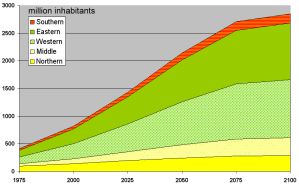 |
 |
|
1. Estimated population development in different parts of Africa, Sources: FAO, United Nations, World Bank; Graph: Elmar Uherek
Please click to enlarge.
|
|
 |
 |
|
2. Africa's population share relative to the world population growth, UN estimation; Graph: Elmar Uherek
Please click to enlarge.
|
|
 |
Often political instability and corruption are seen as major sources of African problems. In fact Africa has seen many wars and local conflicts in the recent decades but at least some wars in Africa are indirectly driven also by hunger.
Hunger and disasters are often reported from Africa but in most cases disasters also include a human component. Many people live in risky and degraded locations without the means to understand and avoid or manage the risks.
|
|
Industrialisation and improvements in agriculture as well as political stabilisation need to go in parallel with the consideration of environmental aspects. Will global warming cause additional catastrophes in particular for Africa?
|
 Climate change scenarios Climate change scenarios
Climate change scenarios for Africa calculated with global circulation models have maybe the lowest level of confidence compared to the other continents. We cannot definitely say which parts of Africa will suffer most from the future climate change, since many of the problems in Africa have also local reasons.
Effects mix up with natural and other human induced climate changes, coming for example from El Niño in East Africa and from the landuse change (deforestation, overgrazing and unsuitable extension of pastureland) in many other regions. These factors are not or hardly considered in climate models.
|
 |
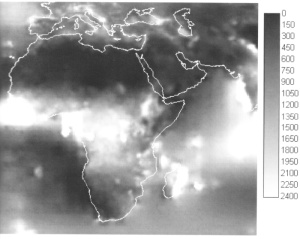 |
 |
|
3. Mean annual precipitation in Africa, in millimeters; adapted from Legates and Willmot (1992). Data compilation from 1920 - 1980
Please click to enlarge.
|
|
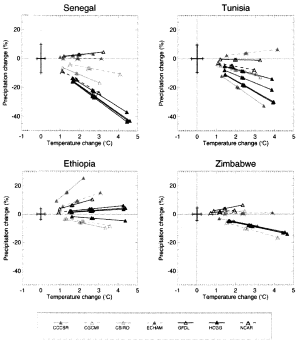 |
 |
|
4. Estimated changes for temperature and precipitation in different regions in Africa. The estimations of 7 different climate models are shown, each of them calculated four climate change scenarios (A2 high, A1 mid, B2 mid, B1 low). The temperature trend goes in all cases to higher temperatures, the more the higher the assumed climate change. The trends in precipitation however are sometimes positive, sometimes negative. The different model calculations do not agree. Source: Hulme et al., 2001
|
|
 |
Another factor which is of particular interest in North Africa is the amount of aerosols and dust present in the air. It is considered in none of the available climate models.
For the temperature the latest calculations give clear indications that the whole of Africa will become warmer, between 0.2°C and 0.5°C per decade. The strongest warming is predicted for the semi-arid Sahara and south central Africa. The temperature increase alone, in the case of rainfall not being more altered than the variability so far, would put some environmental stress on the continent. The calculated trends in rainfall however are not significant enough to exceed the natural variability. Only under extreme warming scenarios, for example, a rainfall decrease is simulated for the Mediterranean coast and a rainfall increase for the Sahel (Nigeria, Chad). But since the models do not simulate well the changes so far in the African climate it is speculative to speak about rainfall trends in Africa at all.
|
 Example Sahel: Example Sahel:
From the 1950s to present the Sahel region has undergone a decrease in rainfall. While the rainy season between May and October did not change, the annual amount of rain was in the range of 650 mm in the 1950s and 1960s and in the range of 500 mm in the 1970s and 1980s. It is assumed by some researchers that this could be related to stronger human land use and deforestation in some African countries. But the mechanisms are not understood in detail. Generally it can be concluded from many studies that Africa has a problem with overuse of savannah lands which turned into drylands and decreasing soil moisture. If the country greens up it also cools down.
|
 |
 |
 |
|
4. Traditional landuse in the Sahel. Overgrazing is often a reason for desertification. Source: FAO
|
|
|
When we speak about environmental problems in Africa we should therefore study in particular the local developments, including the increasing population and use of resources.
|
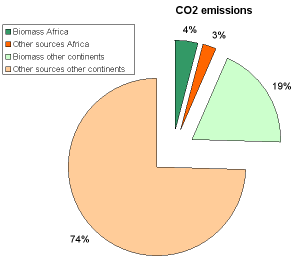 |
 |
|
5. Best estimation of biomass burning to the global CO2 emissions. Diagramm: Elmar Uherek, Data based on Levine 1996
|
|
 |
 Natural and human-induced biomass burning Natural and human-induced biomass burning
It is estimated that about 75% of the world’s population use wood as energy source. 40% of all biomass fires occur in Africa. Most of the fires are savannah fires. Africa has two thirds of the world’s savannah regions and African savannah fires make up 30% of all tropical fires world-wide. Nearly 90% of the fires are human-induced although the burning of savannahs is a natural process and can also be started, for example, by lightning during thunderstorms. However, since the savannah grows again the burning is not necessarily a source of carbon dioxide in the long term as long as there is no loss of biomass through changes in the basic vegetation. Therefore, natural and human induced savannah fires need not contribute to global warming.
|
Fuel wood makes up for about one third (32%) of the African carbon emissions of 566 TgC/year (= million tons carbon per year) of which 337 TgC/year come from biomass burning. Although the amount burned may be clearly less than during savannah fires, the fuel wood is often produced in an unsustainable way, while most of the savannahs take up the CO2 again in the next growth cycle and contribute much less to net carbon dioxide emissions. Since industrial CO2 emissions of Africa make up for less than 2% of all industrial CO2 in the world, biofuel plays a very important role in African emissions.
|
 |
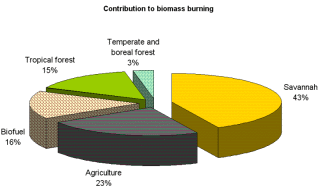 |
 |
|
6. Contribution of biofuel and other fire categories to the total biomass burning. Estimations in % biomass globally burnt. Please click to enlarge. (Andreae, 1991)
|
|
 |
 |
|
7. CO2 emissions in tonnes per capita for various regions in Africa (1995), Kituyi et al. in "Climate change and Africa"
|
|
 |
 Growth of emissions Growth of emissions
It is hardly possible to determine the growth of CO2 emissions in Africa because for most of the countries there is no regular emission inventory. But there is significant growth both in the overall population as well as in the emissions per capita.
For example in 1989 the annual per capita emissions of Kenya were estimated to be 0.29 tonne carbon dioxide. This is 25% of the global average of about 1.16 tonnes and about 3% of a country in Western Europe with about 10 tonnes. In 1997 the emissions in Kenya were estimated to be 0.43 tonnes per capita, which means a nearly 50% growth in eight years. The Republic of South Africa is the only country in Africa with emissions higher than 3 tonnes (7.3 tonnes in 1998, comparable to European countries). |
 Fuelwood and deforestation Fuelwood and deforestation
Generally Africa is a wood-rich continent, which could in the ideal case be managed in a sustainable way and supply enough fuelwood even for a growing population. The wood available is about four times the demand. On the other hand it is difficult to establish sustainable agriculture and wood use. One reason is deforestation for the timber industry. But another reason is also that resources are not always available where the demand is. The population density varies and the infrastructure, the international trading and the know-how in sustainable forestation are in development. Political conflicts and wars amplify the problem. Consequently the single citizen, suffering from hunger and local shortage of resources overuses the ecosystem.
|
 |
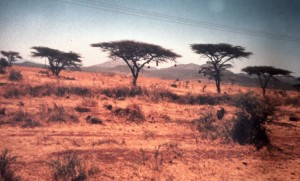 |
 |
|
8. Typical landscape in Kenya, Source: see acknowledgement
|
|
|
Fire wood collection contributes in some way to deforestation in Africa, but often in parallel and as by-process to other logging activities. The most relevant factors accounting for deforestation are land clearance for agriculture and the timber industry.
|
 |
 |
|
9. The fuel type ladder indicates which fuel types are more highly regarded compared to others and more modern from the point of view of the locals. Collage: Elmar Uherek
Please click to enlarge.
|
|
 |
 Fuelwood and social aspects Fuelwood and social aspects
Highly efficient energy resources like kerosene or liquid gas are rare and expensive in Africa. Therefore, fuelwood and charcoal will most likely be major energy resources in the coming decades. Charcoal has lower transport costs per unit energy and a higher energy content per tonne but it is produced inefficiently, so that the scarcity of energy resources is even increased if switching from fuelwood to charcoal.
But the efficiency of use is also influenced by social aspects. The fireplace is an important location in the social life. In regions where plenty of fuelwood is available, people like to keep the fire a bit longer than is needed only for cooking. To sit around the fire is as common in Africa as in many other cultures. The fireplace cannot be easily replaced by more advanced technologies imported from industrialised countries.
|
If advanced cooking devices are spread for free they would be regarded as non-valuable. If they are offered at market prices, they are often not affordable. Even if a device were offered at a reasonable price, it is not assured that if would fulfil the social functions. Fuelwood is in many regions a more reliable energy resource than, for example, kerosene or other petroleum based fuels. Solar cookers are not suitable since most people eat in the evening around or after sunset. For oil driven cookers, if accepted at all, a completely new infrastructure would be necessary in many rural regions. Some researchers with experience in the region are sceptical that firewood will be replaced soon by more clean and modern fuels.
|
 |
 |
 |
|
10. Popular stoves; Source: see acknowledgement
|
|
|
 Health issues Health issues
Perhaps the environmental argument isn’t even the most important one for a replacement of firewood. Inhalation of smoke from indoor open fires is a severe health risk in many households where such fires are used for cooking without a chimney. Pneumonia is the most common form of Acute Lower Respiratory Infections (ALRI) and it is the most important cause of death for children under five years old world-wide. Low birth weight has been associated with exposure to carbon monoxide from biomass burning during pregnancy. However, health studies are often not absolutely conclusive, since usually low-income groups are exposed to such risks and suffer at the same time from other shortages in life quality which can cause similar diseases.
|
|
 Outlook Outlook
Do we need to worry about firewood consumption in Africa in the future? Or will the problem be solved by more modern technologies in the next years anyway?
It is not expected that the usage of fuelwood will decrease in the near future. It was thought that with increasing income households will switch to more modern energy sources. But fuelwood is a very basic energy source and with rising income people rather tend to be a bit less frugal with the wood instead of switching to other resources.
|
But for most households the rising income is out of reach. The population grows and many are still very poor with few chances to move upward on the social ladder, so that often even less-favoured energy resources are used. Progress has still to be made in development programs. Often they are not successful because problems in local infrastructure and know-how are not sufficiently considered. For example in Rwanda several biomass generators were installed in 1980, but 1989 in half of them the digesters fell into disrepair. Even in urban regions, fuelwood is still a major energy source. In Kenya’s towns most household have electricity but still use fuelwood in order to save costs.
|
 |
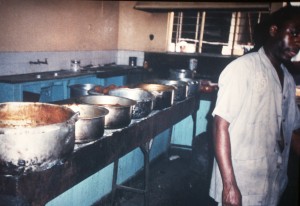 |
 |
|
13. Kitchen in a boarding school: New technologies might be most efficiently tested and more likely introduced in larger kitchens than in private households.
|
|
|
In regions of fuelwood scarcity dung could often replace it (biogas) and is available in large amounts. However dung burning is regarded as a sign of extreme poverty and is therefore often avoided for cultural reasons besides from the technical problems described above.
For the future it has to be discussed, if Africa can and should follow the development of Western countries. Too much unaffordable technology might be needed. Alternatively the continent could make use of regrowing resources and biomass for energy usage, if the present situation could be slowly turned into a professional biomass and wood management.
|
Author:
Elmar Uherek - Max Planck Institute for Chemistry, Mainz
Acknowledgement:
The material for the articles research and context of this edition is based in particular on the book "Climate change and Africa" edited by Pak Sum Low (2005) and field studies carried out by Lackson Marufu and Evans Kituyi in Zimbabwe and Kenya, in cooperation with the ACCENT partner MPI Mainz. Most of the photos shown here have been taken during these field studies which took place in 1996 and 1997. Furthermore we thank Dr. Günter Helas from Max Planck Institute in Mainz for providing the publications and the advice during the development of this edition.
|
|
 |
|







